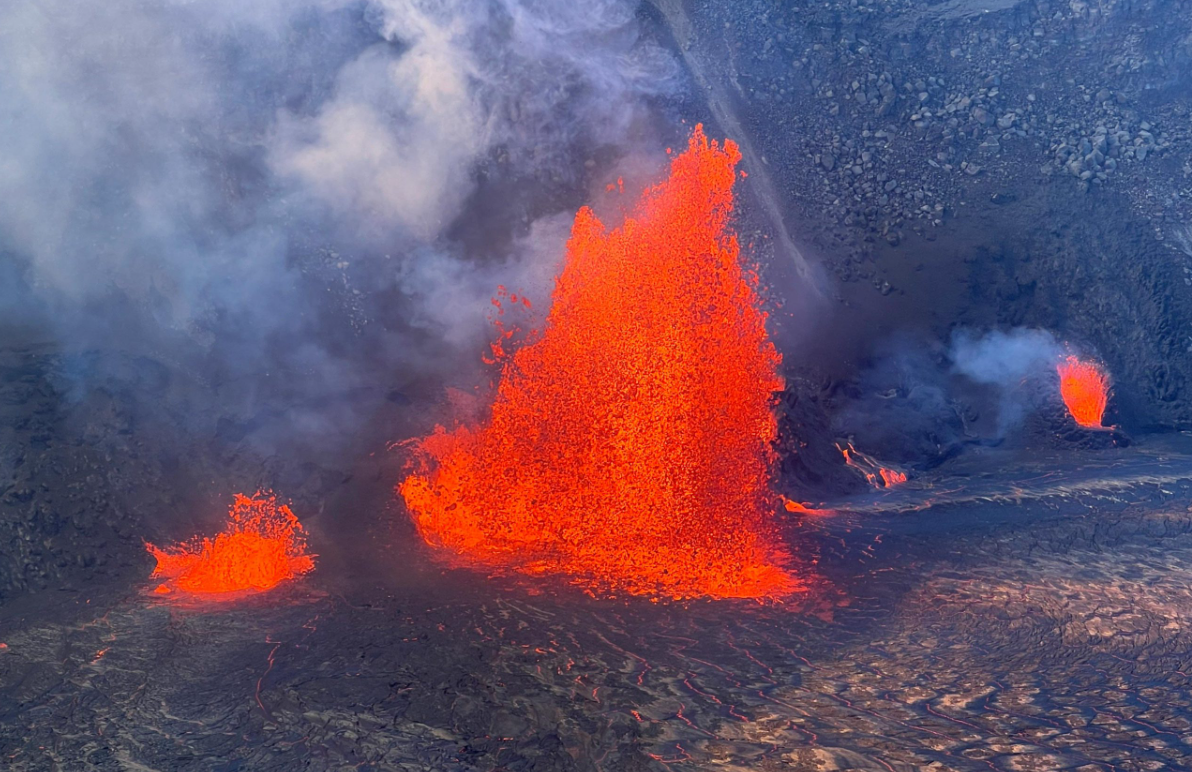The Power of Kīlauea’s Latest Eruption
Kīlauea Volcano Eruption has once again captured global attention, with the U.S. Geological Survey (USGS) releasing breathtaking footage of the latest volcanic activity. On April 1, 2025, the eruption reached a dramatic peak, with lava fountains soaring over 650 feet (200 meters) into the sky. The eruption is part of a series of ongoing episodes within Halemaʻumaʻu Crater, an area known for frequent volcanic activity.
This event has led to lava flows extending over 2,300 feet (700 meters) from the vent, while volcanic debris, including Pele’s Hair, has been carried by the wind, landing on Highway 11 in the Kaʻū District. Scientists continue to monitor the eruption closely, ensuring public safety while capturing stunning visuals of nature’s raw power.
Table of Contents
Kīlauea’s Eruption Timeline & Key Facts
To understand the magnitude of this eruption, here’s a breakdown of key facts:
| Date | Event | Impact |
|---|---|---|
| March 31, 2025 | Episode 16 of eruption begins at 10:57 p.m. HST | Lava fountains reach 650+ feet |
| April 1, 2025 | Lava flows extend over 2,300 feet | Roadways impacted by volcanic debris |
| April 2, 2025 | Authorities issue travel advisories | Travelers advised to avoid affected areas |
| April 3, 2025 | USGS releases live monitoring footage | Public can watch eruption online |
Stunning Visual Highlights of the Eruption
1. Lava Fountains Reaching 650+ Feet
One of the most striking visuals from this eruption is the massive lava fountains bursting from the crater. The force of these eruptions results in rivers of molten rock flowing down the crater floor, creating mesmerizing scenes that have been captured by the USGS.
2. Lava Flows Expanding Across Halemaʻumaʻu Crater
The eruption has produced continuous lava flows, moving rapidly within the Halemaumau Crater, reshaping its landscape. Experts say that these flows are hotter and more fluid than previous eruptions, increasing their reach and speed.
3. Volcanic Debris Covering Roads – A Hazard for Travelers
As lava fountains eject molten rock into the air, volcanic ash and Pele’s Hair (thin strands of volcanic glass) have been carried by wind currents, depositing onto Highway 11. The Hawaiian Volcano Observatory (HVO) has urged travelers to use extreme caution as volcanic debris poses hazards for vehicles.
Is the Eruption a Threat to Communities?
Despite the dramatic visuals, no residential areas are currently at risk. The eruption is contained within the summit caldera, meaning lava is not flowing towards populated regions. However, authorities are closely monitoring gas emissions, as sulfur dioxide levels can pose respiratory risks.
🔹 Safety Tip: If traveling near the affected areas, stay updated with official USGS alerts to avoid hazardous conditions.
Understanding Kīlauea: Why Does It Keep Erupting?
Kilauea is classified as a shield volcano, meaning it has gentle slopes and frequent lava flows. Unlike explosive volcanoes like Mount St. Helens, Kīlauea’s eruptions are more predictable, but they can last for months or even years.
How Kīlauea Compares to Other Volcanoes
| Feature | Kīlauea Volcano (Hawaii) | Mount St. Helens (USA) |
|---|---|---|
| Type of Volcano | Shield Volcano | Stratovolcano |
| Eruption Style | Effusive (Lava Flows) | Explosive (Ash & Pyroclastic Flows) |
| Eruption Frequency | Frequent & Ongoing | Infrequent but Intense |
| Last Major Eruption | 2025 (Ongoing) | 1980 |
Kilauea’s ongoing activity makes it one of the most closely monitored volcanoes in the world.
What’s Next? Predictions for Kilauea’s Activity
While the current eruption is not an immediate threat to communities, geologists predict continued activity for the coming weeks.
Possible Future Scenarios:
- Sustained Lava Flows: The eruption continues, with lava covering more of the summit.
- Increased Gas Emissions: Higher sulfur dioxide levels could affect air quality.
- Eruption Waning: The lava output slows down, marking the end of this phase.
The Hawaiian Volcano Observatory (HVO) is tracking seismic activity to determine whether a larger eruption may occur.
Conclusion: Why This Eruption is Significant
This April 2025 Kilauea eruption is another reminder of Hawaii’s powerful natural forces. The breathtaking USGS footage, combined with expert analysis, allows scientists and the public to witness the raw beauty of Earth’s geology in action.
Key Takeaways:
Kilauea’s eruption is ongoing, with lava fountains exceeding 650 feet.
No immediate threat to communities, but volcanic debris affects roads.
USGS is closely monitoring for future changes in activity.
Travelers should stay informed on air quality and road conditions.





